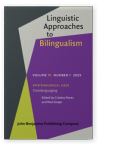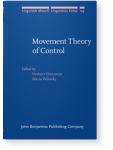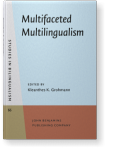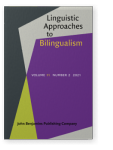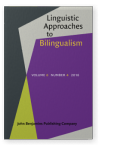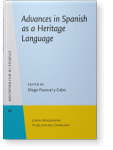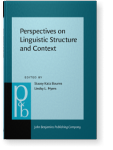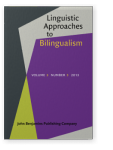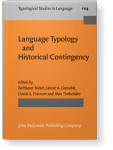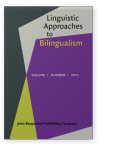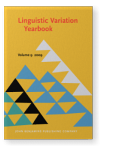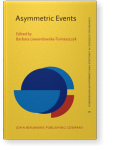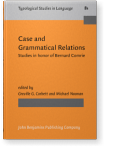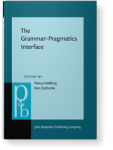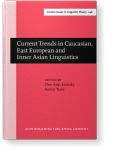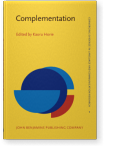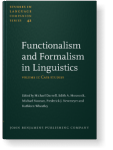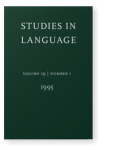Maria Polinsky
List of John Benjamins publications for which Maria Polinsky plays a role.
Journal
Titles
Movement Theory of Control
Edited by Norbert Hornstein and Maria Polinsky
[Linguistik Aktuell/Linguistics Today, 154] 2010. vii, 330 pp.
Subjects Generative linguistics | Syntax | Theoretical linguistics
Causatives and Transitivity
Edited by Bernard Comrie and Maria Polinsky
[Studies in Language Companion Series, 23] 1993. x, 399 pp.
Subjects Functional linguistics | Theoretical linguistics | Typology
2024 Chapter 12. Explaining gender: Lessons from heritage Spanish Multifaceted Multilingualism, Grohmann, Kleanthes K. (ed.), pp. 292–326 | Chapter
This work examines the knowledge of grammatical gender by bilingual speakers for whom Spanish is the weaker language in the dyad, that is, heritage speakers of Spanish. In modeling heritage speakers’ knowledge and use of grammatical gender, we distinguish between gender assignment (how nouns get… read more
2021 Restructuring in heritage grammars: Adjective-noun and numeral-noun expressions in Israeli Russian Linguistic Approaches to Bilingualism 11:2, pp. 222–258 | Article
This study investigates restructuring in heritage language (HL) grammars with a special focus on the driving forces behind changes in the underlying grammar. We evaluate the effect of Age of Onset of bilingualism (AoO) on possible grammatical restructuring. Relatedly, we assess whether HL… read more
2016 Between syntax and discourse: Topic and case marking in heritage speakers and L2 learners of Japanese and Korean Linguistic Approaches to Bilingualism 6:4, pp. 396–439 | Article
This article examines the knowledge of topic and subject particles in heritage speakers and L2 learners of Japanese and Korean. We assume that topic marking is mediated at the syntax-information structure interface, while subject marking pertains to narrow syntax. In comparing phenomena mediated… read more
2016 Looking ahead Advances in Spanish as a Heritage Language, Pascual y Cabo, Diego (ed.), pp. 325–346 | Article
2014 Topics at the left periphery in Russian Perspectives on Linguistic Structure and Context: Studies in honor of Knud Lambrecht, Katz Bourns, Stacey and Lindsy L. Myers (eds.), pp. 109–130 | Article
This paper analyses a paradigm in Russian in which a preposed nominal stranding a numeral can show (paucal) number connectivity, with a gap following the numeral, or can appear in a non-agreeing (plural) form:
(1) theater-paucal/plural, there were three. paucal__
Numerous syntactic diagnostics… read more
2013 Noun classes grow on trees: Noun classification in the North-East Caucasus Language Typology and Historical Contingency: In honor of Johanna Nichols, Bickel, Balthasar, Lenore A. Grenoble, David A. Peterson and Alan Timberlake (eds.), pp. 153–170 | Article
Noun classes (genders) have long played an important role in the understanding of language structure and human categorization. This study presents and analyzes the division of nouns into classes in Tsez (Dido), an endangered Nakh-Dagestanian language of the North-East Caucasus. Computational… read more
2010 Control as movement: Across languages and constructions Movement Theory of Control, Hornstein, Norbert and Maria Polinsky (eds.), pp. 1–42 | Article
2010 Object control in Korean: A backward control impostor Movement Theory of Control, Hornstein, Norbert and Maria Polinsky (eds.), pp. 299–328 | Article
This chapter presents and analyzes three constructions associated with object control in Korean. The constructions differ in the case marking and position of the controllee. We show that in one of these constructions, the controllee, marked in the nominative, appears in the embedded clause. At… read more
2009 Closest conjunct agreement in head final languages Linguistic Variation Yearbook 2009, van Craenenbroeck, Jeroen (ed.), pp. 67–88 | Article
We discuss the phenomenon of closest conjunct agreement with a special focus on head-final languages; we present data from two such languages, Hindi and Tsez, which allow agreement with the rightmost conjunct when the verb follows the conjoined phrase. This contrasts with head-initial languages,… read more
2008 4. What does coordination look like in a head-final language? Asymmetric Events, Lewandowska-Tomaszczyk, Barbara (ed.), pp. 87–102 | Article
Theories of clause linking treat coordination and subordination as mutually exclusive. In this paper, we examine a case where the surface distinction between coordination and subordination is obscured. Concentrating on the-ko construction in Korean, we show that a clause chain can be structurally… read more
2008 Without aspect Case and Grammatical Relations: Studies in honor of Bernard Comrie, Corbett, Greville G. and Michael Noonan (eds.), pp. 263–282 | Article
This paper presents and analyzes the encoding of aspect in Heritage Russian (HR), an incompletely acquired language spoken by those for whom another language became dominant at an early age. The HR aspectual system is distinct from the baseline. Aspectual distinctions are lost due to the leveling… read more
2007 What on earth: Non-referential interrogatives The Grammar–Pragmatics Interface: Essays in honor of Jeanette K. Gundel, Hedberg, Nancy and Ron Zacharski (eds.), pp. 245–262 | Article
2003 Constraints on Reflexivization in Tsez Current Trends in Caucasian, East European and Inner Asian Linguistics: Papers in honor of Howard I. Aronson, Holisky, Dee Ann and Kevin Tuite (eds.), pp. 265–289 | Article
2000 Variation in Complementation Constructions: Long-Distance Agreement in Tsez Complementation: Cognitive and functional perspectives, Horie, Kaoru (ed.), pp. 59–90 | Chapter
1999 Form and Function in Syntax: Relative clauses in Tsez Functionalism and Formalism in Linguistics: Volume II: Case studies, Darnell, Michael, Edith A. Moravcsik, Michael Noonan, Frederick J. Newmeyer and Kathleen Wheatley (eds.), pp. 77–92 | Article
1999 Possessor Raising in a Language that Does Not Have Any External Possession, Payne, Doris L. and Immanuel Barshi (eds.), pp. 523–542 | Article
1998 The great Daghestan case coax Case, Typology and Grammar: In honor of Barry J. Blake, Siewierska, Anna and Jae Jung Song (eds.), pp. 95–114 | Article
1995 Double Objects in Causatives: Towards a Study of Coding Conflict Studies in Language 19:1, pp. 129–221 | Article
1993 Causee and patient in the causative of transitive: coding conflict or doubling of grammatical relations? Causatives and Transitivity, Comrie, Bernard and Maria Polinsky (eds.), pp. 177–240 | Article
